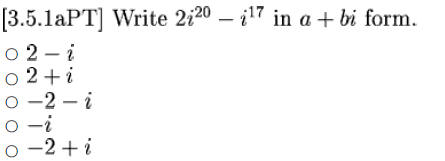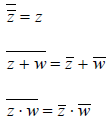Definition
1. ,
,
i is the building block of complex numbers . It handles the difficulty we usually
have to
take a square root of a negative real number . i could be considered the "same"
as x in
the expressions . However, i does have the following properties.

Remark: The powers of I repeat with EVERY 4-th
power.
Example 1

2. Complex number (standard form): a+bi, where a
and b are real numbers. a is
called the real part. B is called the imaginary part. Treating i as x, the
algebraic
operations for real numbers carry over:
• Equality: a+bi = c+di ⇔ a=c and b=d.
• Addition : (a+bi)+(c+di) ⇔ (a+c)+(b+d)i.
• Subtration: (a+bi)-(c+di) ⇔ (a-c)+(b-d)i.
• Multiplication : (a+bi)(c+di)=ac+adi+bci-bd=(ac-bd)+(ad+bc)i.
The following operations are different from real numbers:
• Conjugate: if z=a+bi, then the conjugate of z is a-bi, denoted by
 . (Conjugate
. (Conjugate
is to negate the imaginary part.)

 ,this trick is
important in doing complex division . Actually we can
,this trick is
important in doing complex division . Actually we can
understand this as

Extra Credit
Show that the above 6 identities are true. Can we interpret the identity

by using the difference of squares formula ?
• Division: if z=a+bi and w=c+di, then

Example 2

3. Solving Quadratic Equations with NEGATIVE Discriminants
Recall:|
Δ=b2 − 4ac >0: TWO x-intercepts
Δ=b2 − 4ac =0: ONE x-intercept
Δ= b2 − 4ac <0: NO x-intercept (i.e. no real solutions). However, after we have
introduced complex numbers, we know that, by the quadratic formula,
 , the quadratic function with real
coefficients , in this case, will
, the quadratic function with real
coefficients , in this case, will
have a PAIR of CONJUGATE complex numbers as two solutions . (THEY ARE NOT
X- INTERCEPTS THOUGH .)
Remark: How to take square root of a negative number :
 .
.
Example 3
